Influence of Sudden Changes in Foot Strikes on Loading Rate Variability in Runners
Abstract
1. Introduction
2. Materials and Methods
2.1. Participants
2.2. Experimental Protocol
2.3. Data Analysis
2.4. Statistical Analysis
3. Results
4. Discussion
5. Conclusions
Supplementary Materials
Author Contributions
Funding
Institutional Review Board Statement
Informed Consent Statement
Data Availability Statement
Conflicts of Interest
References
- Oja, P.; Titze, S.; Kokko, S.; Kujala, U.M.; Heinonen, A.; Kelly, P.; Koski, P.; Foster, C. Health benefits of different sport disciplines for adults: A systematic review of observational and intervention studies with meta-analysis. Br. J. Sports Med. 2015, 49, 434–440. [Google Scholar] [CrossRef] [PubMed]
- Junior, L.C.H.; Pillay, J.D.; van Mechelen, W.; Verhagen, E. Meta-analyses of the effects of habitual running on indices of health in physically inactive Adults. Sports Med. 2015, 45, 1455–1468. [Google Scholar] [CrossRef] [PubMed]
- Buist, I.; Bredeweg, S.W.; Bessem, B.; van Mechelen, W.; Lemmink, K.A.P.M.; Diercks, R.L. Incidence and risk factors of running-related injuries during preparation for a 4-mile recreational running event. Br. J. Sports Med. 2010, 44, 598–604. [Google Scholar] [CrossRef] [PubMed]
- van Gent, R.N.; Siem, D.; van Middelkoop, M.; van Os, A.G.; Bierma-Zeinstra, S.M.; Koes, B.W. Incidence and determinants of lower extremity running injuries in long distance runners: A systematic review. Br. J. Sports Med. 2007, 41, 469–480. [Google Scholar] [CrossRef] [PubMed]
- E Taunton, J.; Ryan, M.B.; Clement, D.B.; McKenzie, D.C.; Lloyd-Smith, D.R.; Zumbo, B.D. A retrospective case-control analysis of 2002 running injuries. Br. J. Sports Med. 2002, 36, 95–101. [Google Scholar] [CrossRef]
- Davis, I.S.; Bowser, B.J.; Mullineaux, D.R. Greater vertical impact loading in female runners with medically diagnosed injuries: A prospective investigation. Br. J. Sports Med. 2016, 50, 887–892. [Google Scholar] [CrossRef] [PubMed]
- van der Worp, H.; Vrielink, J.W.; Bredeweg, S.W. Do runners who suffer injuries have higher vertical ground reaction forces than those who remain injury-free? A systematic review and meta-analysis. Br. J. Sports Med. 2016, 50, 450–457. [Google Scholar] [CrossRef]
- Sheerin, K.R.; Reid, D.; Besier, T.F. The measurement of tibial acceleration in runners—A review of the factors that can affect tibial acceleration during running and evidence-based guidelines for its use. Gait Posture 2019, 67, 12–24. [Google Scholar] [CrossRef]
- Zifchock, R.A.; Davis, I.; Hamill, J. Kinetic asymmetry in female runners with and without retrospective tibial stress fractures. J. Biomech. 2006, 39, 2792–2797. [Google Scholar] [CrossRef]
- Crowell, H.P.; Davis, I.S. Gait retraining to reduce lower extremity loading in runners. Clin. Biomech. 2011, 26, 78–83. [Google Scholar] [CrossRef] [PubMed]
- Tenforde, A.S.; Ruder, M.C.; Jamison, S.T.; Singh, P.P.; Davis, I.S. Is symmetry of loading improved for injured runners during novice barefoot running? Gait Posture 2018, 62, 317–320. [Google Scholar] [CrossRef]
- Gruber, A.H. The “impacts cause injury” hypothesis: Running in circles or making new strides? J. Biomech. 2023, 156, 111694. [Google Scholar] [CrossRef] [PubMed]
- Hamill, J.; Gruber, A.H. Is changing footstrike pattern beneficial to runners? J. Sport Health Sci. 2017, 6, 146–153. [Google Scholar] [CrossRef] [PubMed]
- Xu, Y.L.; Yuan, P.; Wang, R.; Wang, D.; Liu, J.; Zhou, H. Effects of foot strike techniques on tunning biomechanics: A systematic review and meta-analysis. Sports Health 2021, 13, 71–77. [Google Scholar] [CrossRef] [PubMed]
- Kulmala, J.-P.; Avela, J.; Pasanen, K.; Parkkari, J. Forefoot strikers exhibit lower running-induced knee loading than rearfoot strikers. Med. Sci. Sports Exerc. 2013, 45, 2306–2313. [Google Scholar] [CrossRef]
- Daoud, A.; Geissler, G.; Wang, F.; Saretsky, J.; Daoud, Y.; Lieberman, D. Foot strike and injury rates in endurance runners: A retrospective study. Med. Sci. Sports Exerc. 2012, 44, 1325–1334. [Google Scholar] [CrossRef] [PubMed]
- Boyer, E.R.; Rooney, B.D.; Derrick, T.R. Rearfoot and midfoot or forefoot impacts in habitually shod runners. Med. Sci. Sports Exerc. 2014, 46, 1384–1391. [Google Scholar] [CrossRef] [PubMed]
- Lieberman, D.E.; Venkadesan, M.; Werbel, W.A.; Daoud, A.I.; D’andrea, S.; Davis, I.S.; Mang’eni, R.O.; Pitsiladis, Y. Foot strike patterns and collision forces in habitually barefoot versus shod runners. Nature 2010, 463, 531–535. [Google Scholar] [CrossRef] [PubMed]
- Rice, H.M.; Jamison, S.T.; Davis, I.S. Footwear matters: Influence of footwear and foot strike on load rates during running. Med. Sci. Sports Exerc. 2016, 48, 2462–2468. [Google Scholar] [CrossRef] [PubMed]
- Futrell, E.E.; Jamison, S.T.; Tenforde, A.S.; Davis, I.S. Relationships between habitual cadence, footstrike, and vertical load rates in runners. Med. Sci. Sports Exerc. 2018, 50, 1837–1841. [Google Scholar] [CrossRef] [PubMed]
- Milner, C.E.; Ferber, R.; Pollard, C.D.; Hamill, J.; Davis, I.S. Biomechanical factors associated with tibial stress fracture in female runners. Med. Sci. Sports Exerc. 2006, 38, 323–328. [Google Scholar] [CrossRef]
- Barton, C.J.; Bonanno, D.R.; Carr, J.; Neal, B.S.; Malliaras, P.; Franklyn-Miller, A.; Menz, H.B. Running retraining to treat lower limb injuries: A mixed-methods study of current evidence synthesised with expert opinion. Br. J. Sports Med. 2016, 50, 513–526. [Google Scholar] [CrossRef]
- Neal, B.S.; Barton, C.J.; Gallie, R.; O’halloran, P.; Morrissey, D. Runners with patellofemoral pain have altered biomechanics which targeted interventions can modify: A systematic review and meta-analysis. Gait Posture 2016, 45, 69–82. [Google Scholar] [CrossRef]
- Roper, J.L.; Harding, E.M.; Doerfler, D.; Dexter, J.G.; Kravitz, L.; Dufek, J.S.; Mermier, C.M. The effects of gait retraining in runners with patellofemoral pain: A randomized trial. Clin. Biomech. 2016, 35, 14–22. [Google Scholar] [CrossRef]
- Luedke, L.E.; Heiderscheit, B.C.; Williams, D.S.B.; Rauh, M.J. Influence of step rate on shin injury and anterior knee pain in high school runners. Med. Sci. Sports Exerc. 2016, 48, 1244–1250. [Google Scholar] [CrossRef]
- Hobara, H.; Sato, T.; Sakaguchi, M.; Nakazawa, K. Step frequency and lower extremity loading during running. Int. J. Sports Med. 2012, 33, 310–313. [Google Scholar] [CrossRef]
- Cheung, R.T.; Davis, I.S. Landing pattern modification to improve patellofemoral pain in runners: A case series. J. Orthop. Sports Phys. Ther. 2011, 41, 914–919. [Google Scholar] [CrossRef]
- Diebal, A.R.; Gregory, R.; Alitz, C.; Gerber, J.P. Forefoot running improves pain and disability associated with chronic exertional compartment syndrome. Am. J. Sports Med. 2012, 40, 1060–1067. [Google Scholar] [CrossRef] [PubMed]
- Chan, Z.Y.; Zhang, J.H.; Au, I.P.; An, W.W.; Shum, G.L.; Ng, G.Y.; Cheung, R.T. Gait Retraining for the Reduction of Injury Occurrence in Novice Distance Runners: 1-Year Follow-up of a Randomized Controlled Trial. Am. J. Sports Med. 2017, 46, 388–395. [Google Scholar] [CrossRef] [PubMed]
- Samaan, C.D.; Rainbow, M.J.; Davis, I.S. Reduction in ground reaction force variables with instructed barefoot running. J. Sport Health Sci. 2014, 3, 143–151. [Google Scholar] [CrossRef]
- Cowin, J.; Nimphius, S.; Fell, J.; Culhane, P.; Schmidt, M. A proposed framework to describe movement variability within sporting tasks: A scoping review. Sports Med.—Open 2022, 8, 85. [Google Scholar] [CrossRef] [PubMed]
- Stergiou, N.; Harbourne, R.; Cavanaugh, J. Optimal movement variability: A new theoretical perspective for neurologic physical therapy. J. Neurol. Phys. Ther. 2006, 30, 120–129. [Google Scholar] [CrossRef] [PubMed]
- Tam, N.; Wilson, J.L.A.; Coetzee, D.R.; van Pletsen, L.; Tucker, R. Loading rate increases during barefoot running in habitually shod runners: Individual responses to an unfamiliar condition. Gait Posture 2016, 46, 47–52. [Google Scholar] [CrossRef]
- Hunter, J.G.; Smith, A.M.; Sciarratta, L.M.; Suydam, S.; Shim, J.K.; Miller, R.H. Standardized lab shoes do not decrease loading rate variability in recreational runners. J. Appl. Biomech. 2020, 36, 340–344. [Google Scholar] [CrossRef] [PubMed]
- Bredeweg, S.W.; Kluitenberg, B.; Bessem, B.; Buist, I. Differences in kinetic variables between injured and noninjured novice runners: A prospective cohort study. J. Sci. Med. Sport 2013, 16, 205–210. [Google Scholar] [CrossRef] [PubMed]
- Hreljac, A.; Marshall, R.N.; Hume, P.A. Evaluation of lower extremity overuse injury potential in runners. Med. Sci. Sports Exerc. 2000, 32, 1635–1641. [Google Scholar] [CrossRef] [PubMed]
- Azevedo, L.B.; Lambert, M.I.; Vaughan, C.L.; O’connor, C.M.; Schwellnus, M.P. Biomechanical variables associated with Achilles tendinopathy in runners. Br. J. Sports Med. 2009, 43, 288–292. [Google Scholar] [CrossRef]
- Bredeweg, S.; Buist, I.; Kluitenberg, B. Differences in kinetic asymmetry between injured and noninjured novice runners: A prospective cohort study. Gait Posture 2013, 38, 847–852. [Google Scholar] [CrossRef] [PubMed]
- Messier, S.P.; Edwards, D.G.; Martin, D.F.; Lowery, R.B.; Cannon, D.W.; James, M.K.; Curl, W.W.; Read, H.M.; Hunter, D.M. Etiology of iliotibial band friction syndrome in distance runners. Med. Sci. Sports Exerc. 1995, 27, 951–960. [Google Scholar] [CrossRef] [PubMed]
- Gaudette, L.W.; Bradach, M.M.; de Souza Junior, J.R.; Heiderscheit, B.; Johnson, C.D.; Posilkin, J.; Rauh, M.J.; Sara, L.K.; Wasserman, L.; Hollander, K.; et al. Clinical application of gait retraining in the injured runner. J. Clin. Med. 2022, 11, 6497. [Google Scholar] [CrossRef] [PubMed]
- Hamill, J.; Gruber, A.H.; Derrick, T.R. Lower extremity joint stiffness characteristics during running with different footfall patterns. Eur. J. Sport Sci. 2014, 14, 130–136. [Google Scholar] [CrossRef] [PubMed]
- Stearne, S.M.; Alderson, J.A.; Green, B.A.; Donnelly, C.J.; Rubenson, J. Joint kinetics in rearfoot versus forefoot running: Implications of switching technique. Med. Sci. Sports Exerc. 2014, 46, 1578–1587. [Google Scholar] [CrossRef] [PubMed]
- Knorz, S.; Kluge, F.; Gelse, K.; Schulz-Drost, S.; Hotfiel, T.; Lochmann, M.; Eskofier, B.; Krinner, S. Three-dimensional biomechanical analysis of rearfoot and forefoot running. Orthop. J. Sports Med. 2017, 5, 2325967117719065. [Google Scholar] [CrossRef] [PubMed]
- Zhang, J.H.; An, W.W.; Au, I.P.; Chen, T.L.; Cheung, R.T. Comparison of the correlations between impact loading rates and peak accelerations measured at two different body sites: Intra- and inter-subject analysis. Gait Posture 2016, 46, 53–56. [Google Scholar] [CrossRef]
- Divert, C.; Mornieux, G.; Baur, H.; Mayer, F.; Belli, A. Mechanical comparison of barefoot and shod running. Int. J. Sports Med. 2005, 26, 593–598. [Google Scholar] [CrossRef] [PubMed]
- Chang, Y.-H.; Huang, H.-W.C.; Hamerski, C.M.; Kram, R. The independent effects of gravity and inertia on running mechanics. J. Exp. Biol. 2000, 203, 229–238. [Google Scholar] [CrossRef] [PubMed]
- Ludbrook, J. Advantages of permutration (randomization) tests in clinical and experimental pharmacology and physiology. Clin. Exp. Pharmacol. Physiol. 1994, 21, 673–686. [Google Scholar] [CrossRef]
- Collingridge, D.S. A Primer on quantitized data analysis and permutation testing. J. Mix. Methods Res. 2013, 7, 81–97. [Google Scholar] [CrossRef]
- Hasegawa, H.; Yamauchi, T.; Kraemer, W.J. Foot strike patterns of runners at the 15-km point during an elite-level half marathon. J. Strength Cond. Res. 2007, 21, 888–893. [Google Scholar] [CrossRef] [PubMed]
- Larson, P.; Higgins, E.; Kaminski, J.; Decker, T.; Preble, J.; Lyons, D.; McIntyre, K.; Normile, A. Foot strike patterns of recreational and sub-elite runners in a long-distance road race. J. Sports Sci. 2011, 29, 1665–1673. [Google Scholar] [CrossRef]
- Yu, L.; Mei, Q.; Xiang, L.; Liu, W.; Mohamad, N.I.; István, B.; Fernandez, J.; Gu, Y. Principal component analysis of the running ground reaction forces with different speeds. Front. Bioeng. Biotechnol. 2021, 9, 629809. [Google Scholar] [CrossRef] [PubMed]
- Yin, L.; Hu, X.; Lai, Z.; Liu, K.; Wang, L. Leg stiffness and vertical stiffness of habitual forefoot and rearfoot strikers during running. Appl. Bionics Biomech. 2020, 2020, 8866340. [Google Scholar] [CrossRef] [PubMed]
- Chambon, N.; Delattre, N.; Guéguen, N.; Berton, E.; Rao, G. Shoe drop has opposite influence on running pattern when running overground or on a treadmill. Eur. J. Appl. Physiol. 2015, 115, 911–918. [Google Scholar] [CrossRef] [PubMed]
- Williams, D.S.; McClay, I.S.; Manal, K.T. Lower extremity mechanics in runners with a converted forefoot strike pattern. J. Appl. Biomech. 2000, 16, 210–218. [Google Scholar] [CrossRef]
- Altman, A.R.; Davis, I.S. Barefoot running: Biomechanics and implications for running injuries. Curr. Sports Med. Rep. 2012, 11, 244–250. [Google Scholar] [CrossRef]
- Valenzuela, K.A.; Lynn, S.K.; Mikelson, L.R.; Noffal, G.J.; Judelson, D.A. Effect of acute alterations in foot strike patterns during running on sagittal plane lower limb kinematics and kinetics. J. Sports Sci. Med. 2015, 14, 225–232. [Google Scholar] [PubMed]
- Mo, A.; Izzi, F.; Haeufle, D.F.B.; Badri-Spröwitz, A. Effective viscous damping enables morphological computation in legged locomotion. Front. Robot. AI 2020, 7, 110. [Google Scholar] [CrossRef] [PubMed]
- Moore, I.S.; Dixon, S.J. Changes in sagittal plane kinematics with treadmill familiarization to barefoot running. J. Appl. Biomech. 2014, 30, 626–631. [Google Scholar] [CrossRef] [PubMed]
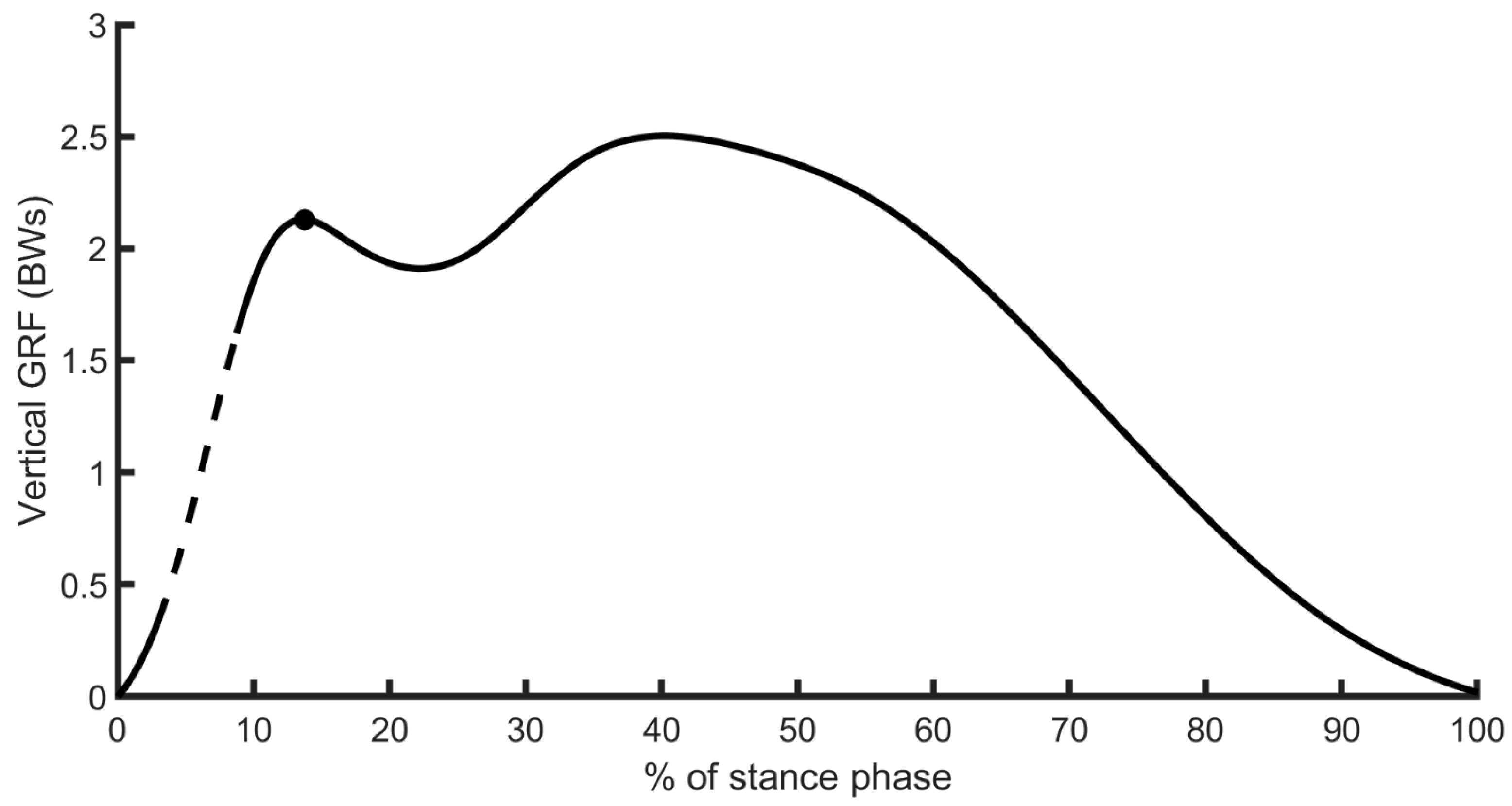
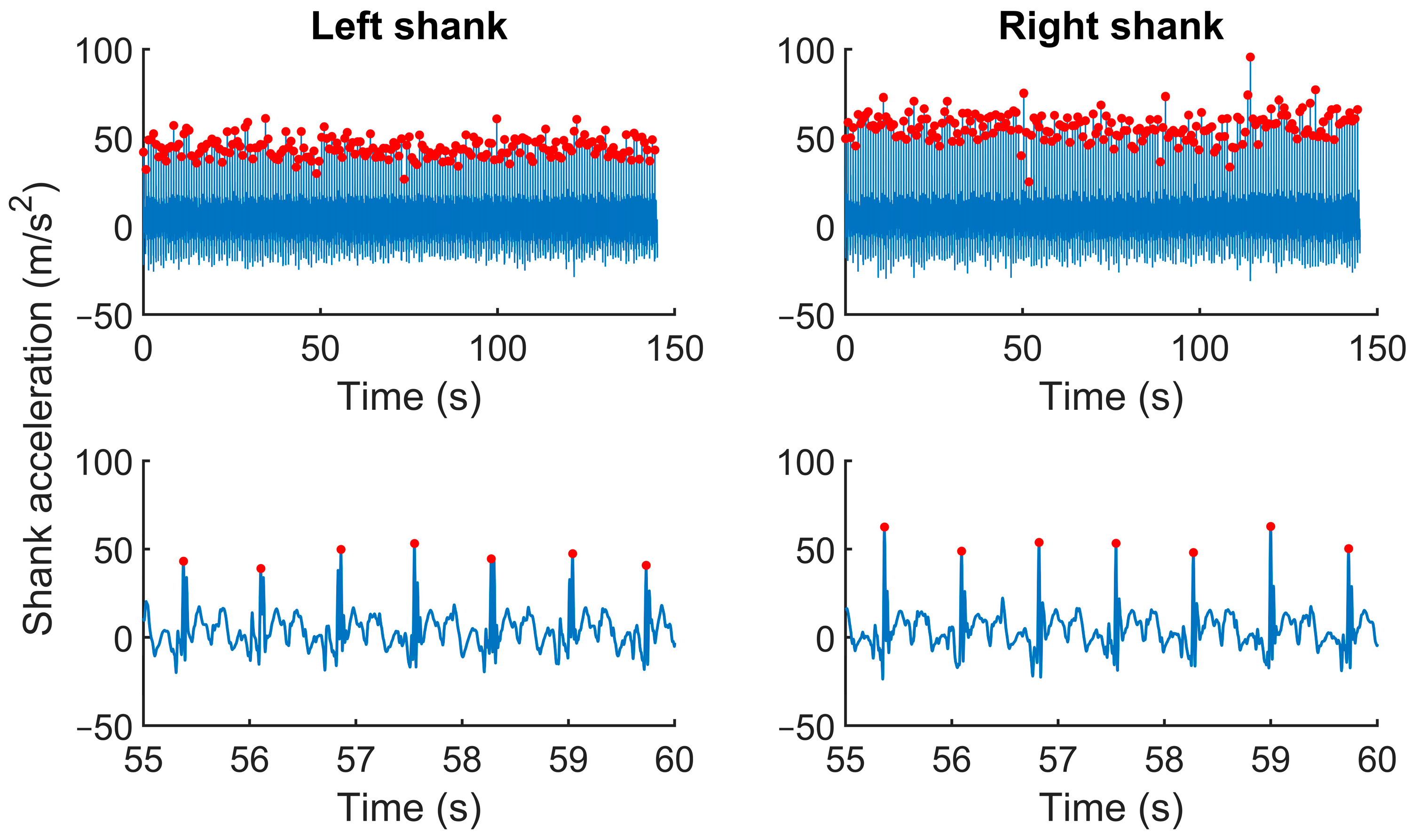
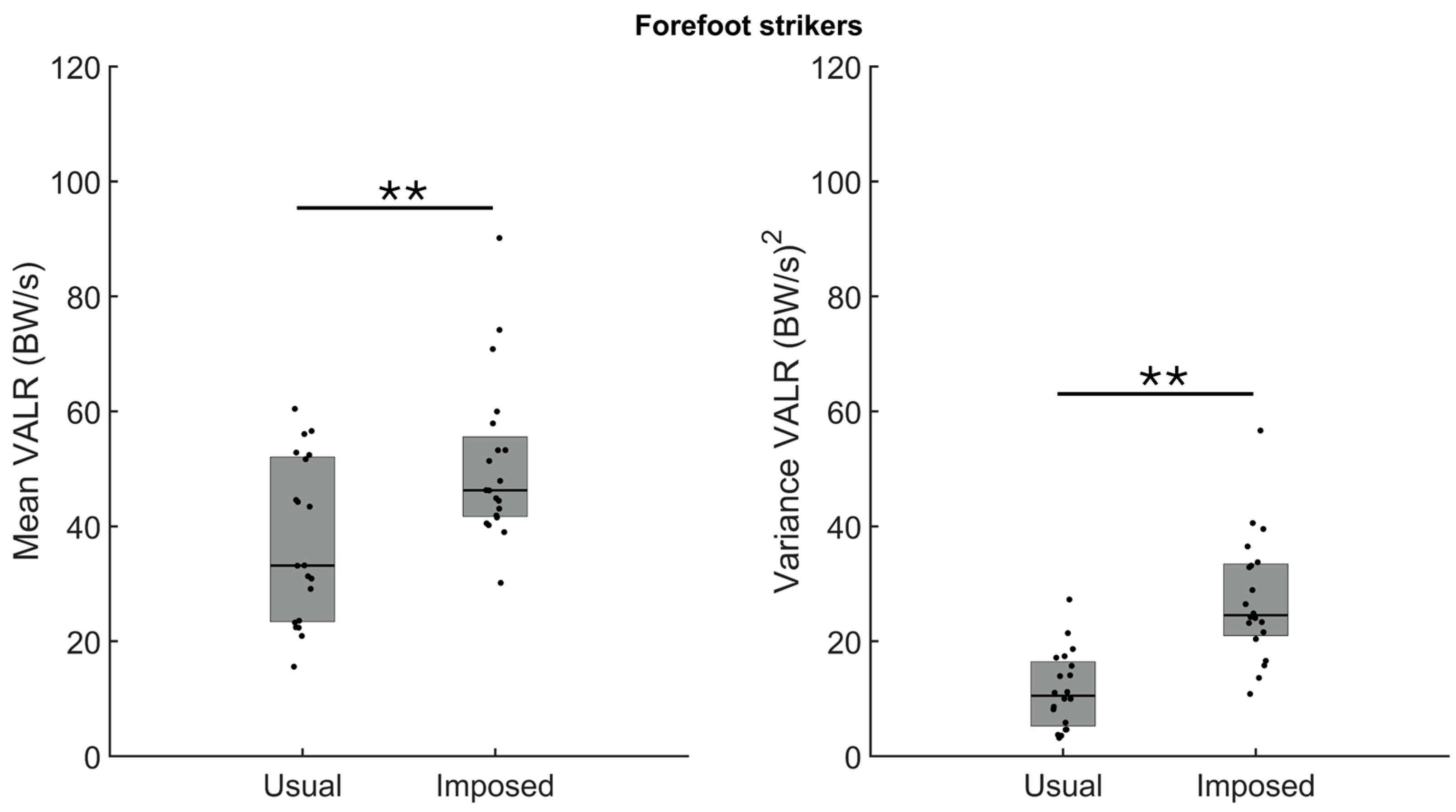


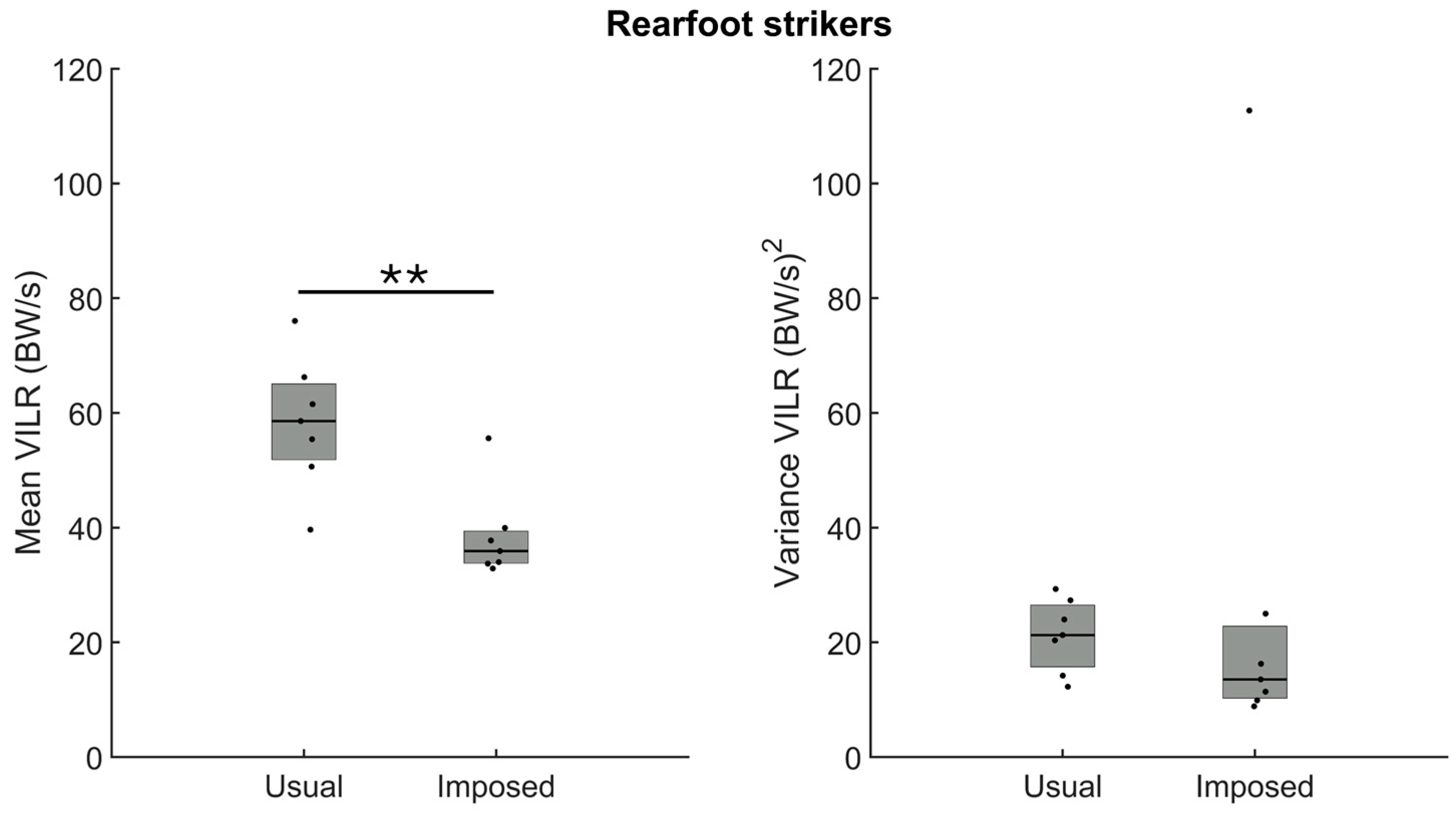
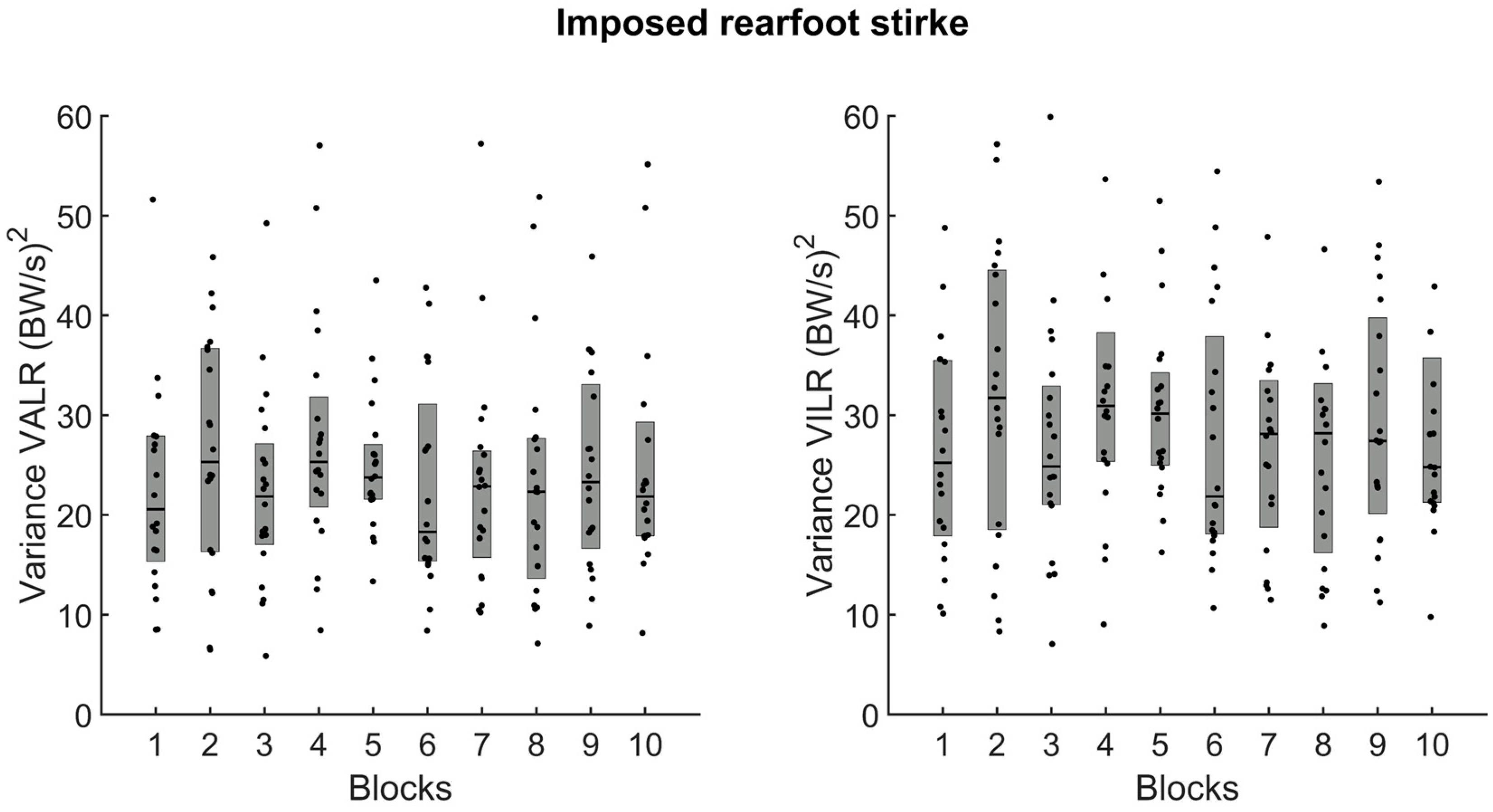
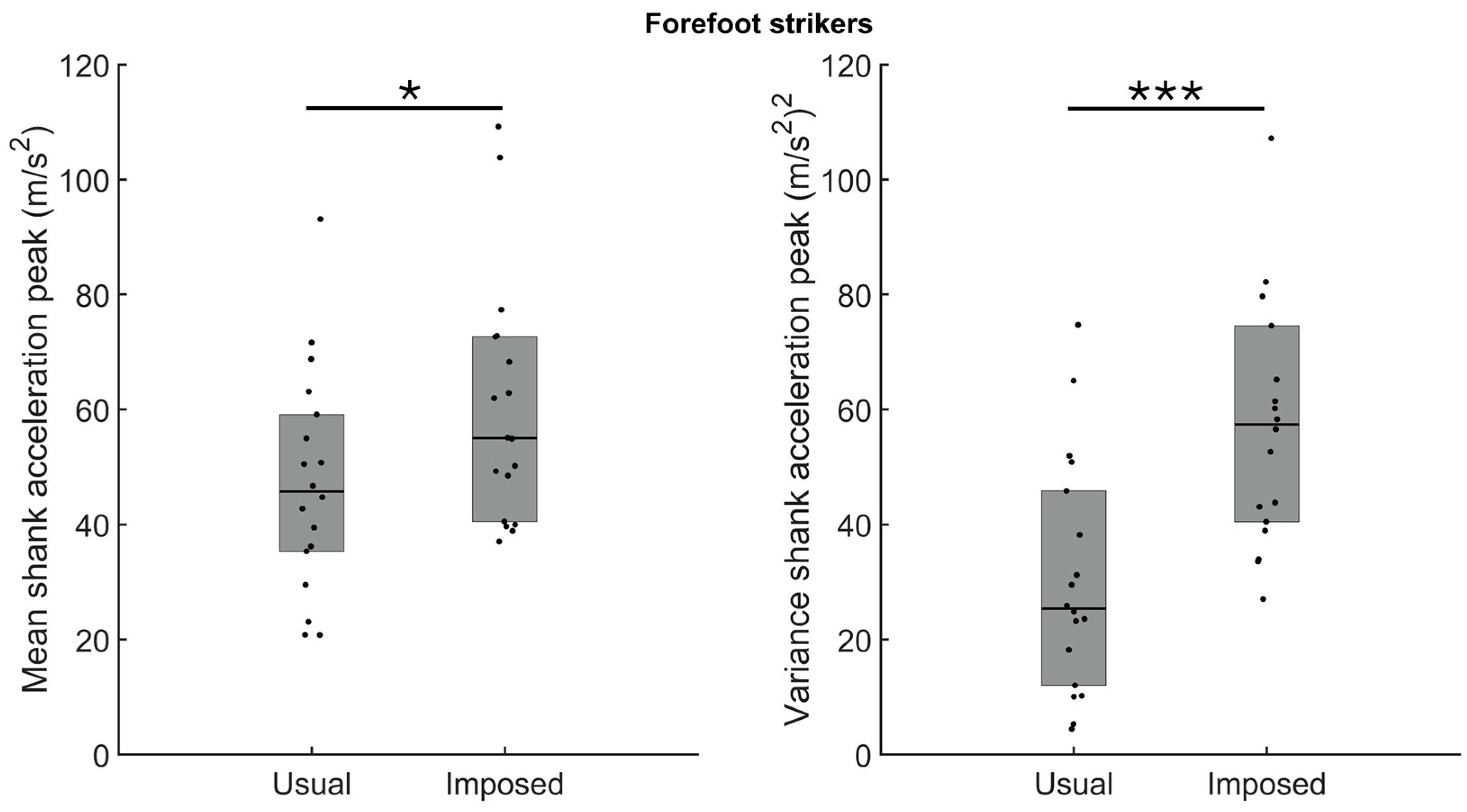

| Male (n = 16) | Female (n = 11) | |
|---|---|---|
| Age (y) | 22.8 ± 2.9 | 22.1 ± 3.1 |
| Height (m) | 1.78 ± 0.06 | 1.62 ± 0.1 |
| Body mass (kg) | 68.1 ± 9.3 | 58.0 ± 4.2 |
| Distance (km/week) | 57.5 ± 36.7 | 37.3 ± 23.5 |
| Speed (m/s) | 2.78 ± 0.31 | 2.45 ± 0.35 |
| Usual foot strike | 13 FFS, 3 RFS | 7 FFS, 4 RFS |
Disclaimer/Publisher’s Note: The statements, opinions and data contained in all publications are solely those of the individual author(s) and contributor(s) and not of MDPI and/or the editor(s). MDPI and/or the editor(s) disclaim responsibility for any injury to people or property resulting from any ideas, methods, instructions or products referred to in the content. |
© 2024 by the authors. Licensee MDPI, Basel, Switzerland. This article is an open access article distributed under the terms and conditions of the Creative Commons Attribution (CC BY) license (https://creativecommons.org/licenses/by/4.0/).
Share and Cite
Chabot, M.; Thibault-Piedboeuf, A.; Nault, M.-L.; Roy, J.-S.; Dixon, P.C.; Simoneau, M. Influence of Sudden Changes in Foot Strikes on Loading Rate Variability in Runners. Sensors 2024, 24, 8163. https://doi.org/10.3390/s24248163
Chabot M, Thibault-Piedboeuf A, Nault M-L, Roy J-S, Dixon PC, Simoneau M. Influence of Sudden Changes in Foot Strikes on Loading Rate Variability in Runners. Sensors. 2024; 24(24):8163. https://doi.org/10.3390/s24248163
Chicago/Turabian StyleChabot, Maxime, Alexandre Thibault-Piedboeuf, Marie-Lyne Nault, Jean-Sébastien Roy, Philippe C. Dixon, and Martin Simoneau. 2024. "Influence of Sudden Changes in Foot Strikes on Loading Rate Variability in Runners" Sensors 24, no. 24: 8163. https://doi.org/10.3390/s24248163
APA StyleChabot, M., Thibault-Piedboeuf, A., Nault, M.-L., Roy, J.-S., Dixon, P. C., & Simoneau, M. (2024). Influence of Sudden Changes in Foot Strikes on Loading Rate Variability in Runners. Sensors, 24(24), 8163. https://doi.org/10.3390/s24248163







